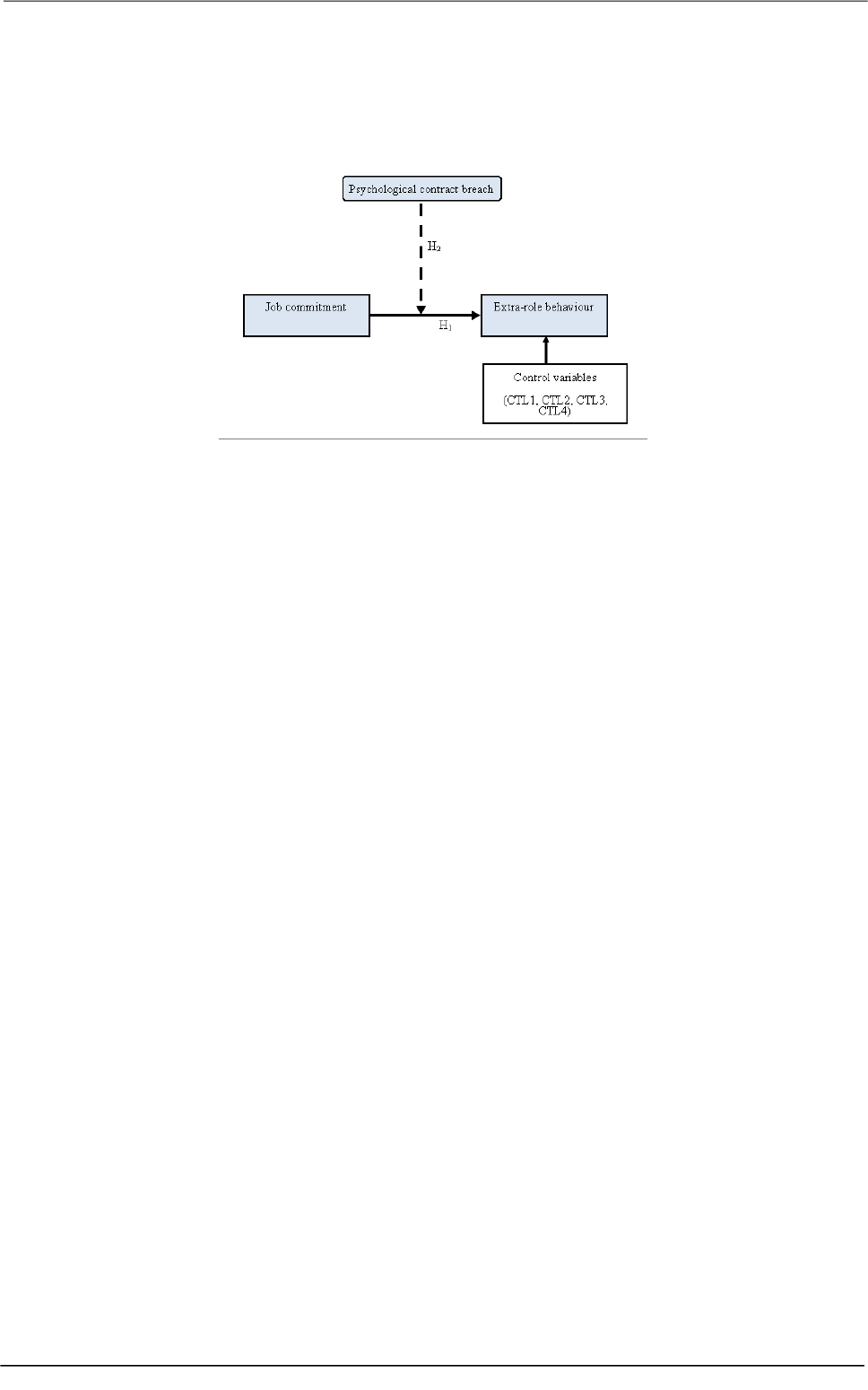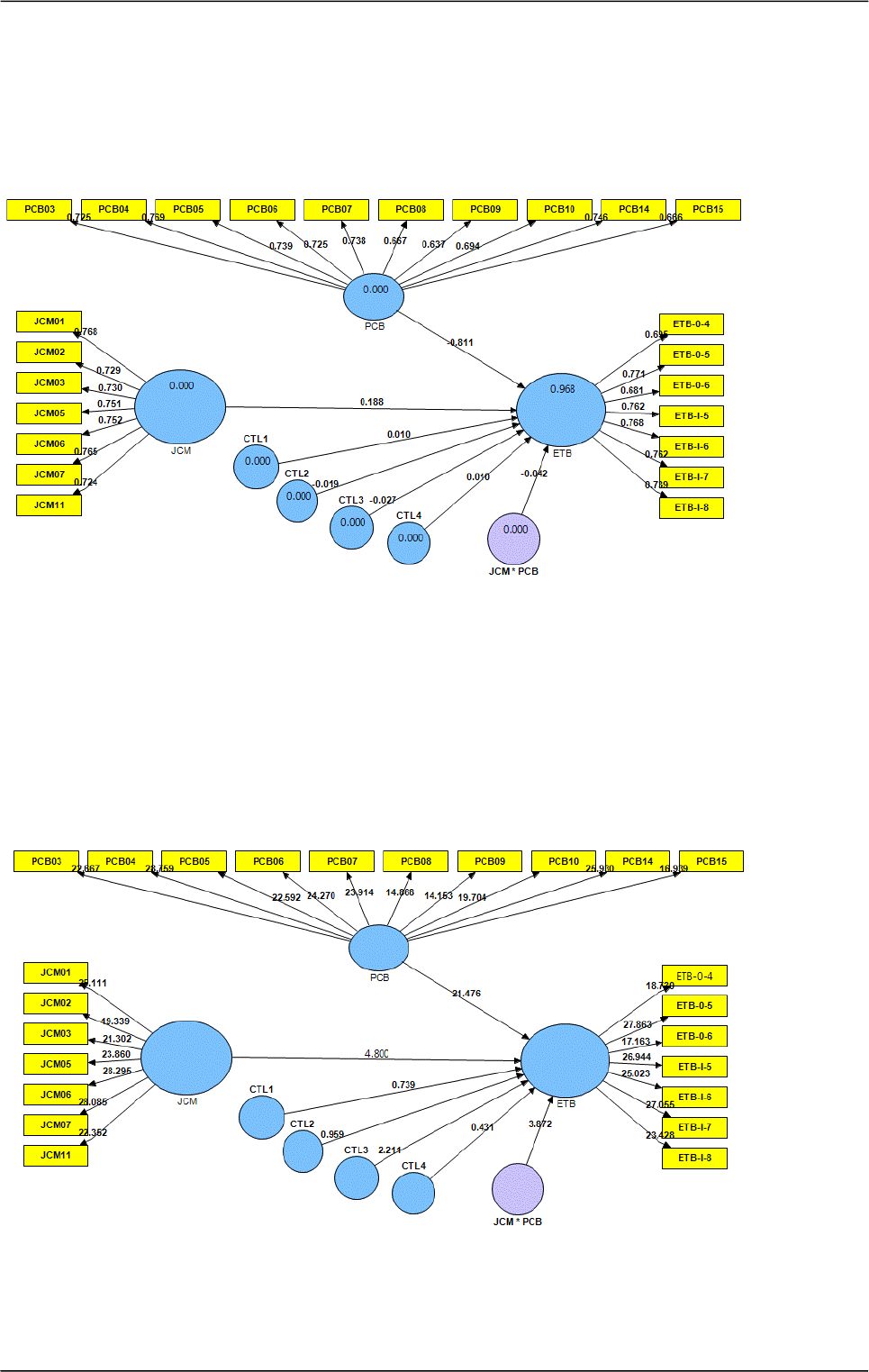
Journal of Psychological Perspective. December 2021; 3(2): 67-76
https://doi.org/10.47679/jopp.321372021
ISSN 2502-4825 (print), ISSN 2502-9495 (online)
UKInstitute
Psychological contract breach as a stressor in the physician’s job
commitment–extra-role behaviour relationship
Samuel Koomson
Published online: 25 December 2021.
Abstract
This paper finds out if a committed physician will go the extra mile for his/her employer when faced with psychological
contract breach (PCB), a psychosocial stressor. Data from 214 physicians across 26 health-care units in the Upper East (UE)
and Upper West (UW) regions of Ghana were analysed. A semi-structured, pre-tested and validated questionnaire was
utilised. Research philosophy was positivism, research approach was quantitative, research design was explanatory, and
study design was cross-sectional. Preliminary tests were conducted. Both reflective measurement and structural models
were examined. PLS algorithm tool and bootstrapping procedure were used. Control variables were sex, age, employment
type and tenure. A significant level was set at 5%. Smart PLS and IBM SPSS software were employed. In the end, physician’s
commitment work (JCM) positively and significantly predicted extra-role behaviour (ETB). Also, PCB significantly interacted
with JCM to predict ETB, such that the relationship between JCT and ETB was stronger when PCB was low than when it was
high. Creating a balanced, fulfilled and harmonious hospital–physician relationship will transform the workplace into a less
stressful, more meaningful and purposeful atmosphere for the benefit other health-care professionals, patients and the
health-care organisation at large.
Keywords: attitudes; discretionary behaviour; hospital–physician exchanges; moderation; partial least square-structural
equation modeling; unfulfilled expectations
INTRODUCTION
Background
In the health-care setting, the conception of a
psychological contract (PC) indicates that a set of
anticipations always exist between every health-care
worker of a health-care unit and the several executives and
others in that unit (Huy & Takahashi, 2018).
Health-care
units, on one hand, may expect health-care professionals to
do their best on behalf of the health-care unit: to make
themselves available for the heath-care facility; to be fully
committed to its values, to be compliant and loyal; and to
improve the image of the facility with its patients and
suppliers (Rousseau & Greller, 1994). Health-care
professionals, on the other hand, may expect to be treated
impartially as humans, to be offered assignments that uses
their abilities, to be paid fairly in line with their efforts, to be
able to show competence, to have opportunities for future
development, to know what is expected of them, to be given
feedback-preferably positive-on their performance, to be
part of decision-making, and to have faith in the executives
of the health-care facility to keep their promises (Guest et
al., 1996). This statement underscores the 8
th
and 16
th
UN
Sustainable Development Goal, which seeks to offer decent
work and economic development for everyone, and enhance
peaceable and inclusive community for sustainable
development respectively (Catholic Agency for Overseas
Development, 2015).
Gallup’s State of the American Workplace Report (2017)
advocates that health-care professionals must be in a setting
where there is mutual trust, recognition and respect for one
another’s efforts and results. Ghana Healthcare Quality
Strategy Report (2017) also declares the relevance for
health-care executives to construct a philosophy of “joy at
work” in terms of financing, logistics, recognition and
rewards to give room for health-care workers to solemnly
work as a team, and deliver high quality care, and be
motivated to continuously improve quality. The assertion
put forward by the Ghana Healthcare Quality Strategy
Report (2017) matches up with the core mission of the
Ghana Health Service (2017), which pursues to establish a
more equitable, efficient, accessible and responsive health-
care system.
A PC is said to have been honoured when the health-
care facility meets its obligations to an health-care
professional, from the professional’s vantage, and it serves
to build upon the social exchange element (Karagonlar et al.,
R E S E A R C H A R T I C L E
Department of Management University of Cape Coast (UCC)
Ghana
*) corresponding author
Samuel Koomson
Email: [email protected]

Journal of Psychological Perspective, 3(2), December 2021, – 68
UKInstitute
2016), which are founded on trust, reciprocation and reward
(Blau, 1964). In contrast, a PC is said to have been breached
if the health-care facility fails to deliver on an expected
obligation to the professional and this expected obligation
can either be documented or undocumented (Robinson &
Rousseau, 1994). When a PC is honoured, health-care
professionals are likely to be highly committed to their jobs.
On the contrary, when a PC is in breach or unfulfilled, there
is the tendency for health-care professionals to show low
levels of JCM (Agbozo et al., 2018). Job commitment is a
strong desire to remain a member of a particular
organisation, the desire to strive at what organisation
desires and certain beliefs and acceptance of value and
purpose of the organisation (Akbar et al., 2018).
The negative relationship between PCB and JCM is
described by the social exchange theory (SET), which one of
the most applied conceptual paradigms for understanding
workplace behaviour (Cropanzano et al., 2017; Opoku
Mensah & Koomson, 2021). According to the SET, when the
organisation helps the employee out, the employee is likely
to do something in return for the organisation. But, if the
employee senses that the organisation does not have his/her
best interest at heart, the employee is likely to show
undesirable work attitudes (Organ, 2018), such low level of
JCM.
An employee who is less committed is not likely to go
an extra mile for his/her organisation. A committed
employee, on the other hand, presents benefits to co-
workers, customers, and the organisation at large. As an
evidence, Leephaijaroen (2016) shows that continuance
commitment and affective commitment positively and
significantly affected citizenship behaviour among
university support workers in Thailand. Anggraeni et al.
(2017) also report that JCM positively and significantly
influenced citizenship behaviour among Indonesian young
entrepreneurs. Thus, it is understood that ground-breaking
transformations in organisations are a result of committed
employees. The positive relationship JCM and ETB is
described the resource-based theory (RBT). The RBT regards
a committed employee as a firm resource or asset which is
able to generate value or competitive advantage by being
rare and difficult to imitate by rival firms (Rezaei & Ortt,
2018). This competitive advantage converts into positive
organisational outcomes, in the form of discretionary
behaviour for the benefit of co-workers, customers and the
organisation itself. Thus, the SET and RBT aids in
understanding the relationship between PCB and JCM, and
JCM and ETB respectively.
The SET, as power as it is, offers additional
understanding on the negative relationship between PCB
and ETB, such that when an employee feels breached
psychological, he/she is unlikely to demonstrate
discretionary behaviour for the benefit of the
employer/organisation. Organ (2018) educates that ETB is a
free, voluntary and selfless interest for the good of others,
such as organisation, clients/customers, clients’ relatives or
groups. In the healthcare sector in particular, Gupta (2019)
explains that ETB exhibited by health-care professionals has
the potential of boosting the satisfaction of co-workers,
patients, patients’ friends, and their relatives. As proof, Shen
et al
.
(2019) report a negative linkage between PCB and ETB
among employees and supervisors in China. Koomson and
Opoku Mensah (2020) also share that PCB caused medical
doctors to show low citizenship behaviour in Ghana.
Beside the SET and the RBT, this study utilises the
activation theory (ACT) to describe the proposed
moderating role of PCB in the direct relationship between
JCM and ETB, such that the direct positive relationship
between JCM and ETB may be weakened by a high-PCB, but
strengthened by a fulfilled PC or low-PCB. The ACT (Gardner,
1986; Gardner & Cummings, 1988) holds that too much
stress from the employer can damaged an employee’s
ability to perform, particularly for complex and difficult task
(Gardner, 1990), thereby negating the tendency of that
employee to show discretionary behaviour. This
assumption has been tested by related authors in different
models. For example, Addae et al. (2006) reveal that
employees with high affective commitment who perceived
a PCB were more likely to think about quitting their jobs.
Paille et al. (2014) find that PCB moderated the direct
linkage between perceived organisational support and job
satisfaction. Paillé and Rainer (2015) disclose that PCB
moderated the linkage between perceived organisational
support and eco-initiatives. Haque et al. (2016) educate that
PCB moderated the direct positive relationship between
psychological capital and work engagement, and the direct
negative relationship between psychological capital and
burnout.
Gupta et al. (2016) argues that PCB moderated the
connection between perceived organisational support and
work engagement, as well as the nexus between perceived
organisational support and ETB. Erkutlu and Chafra (2016)
uncover that high-PCB weakened the positive relationship
between benevolent leadership and psychological well-
being. Santhanam et al. (2017) discover that PCB moderated
the nexus between human resource management practices
and turnover. Against this background, this study seeks to
examine the direct relationship between JCT and ETB among
physicians in Ghana, and further test the moderating role of
PCB, a psychosocial stressor, on this direct relationship.
Problem statement
Statistics retrieved from Ghana Health Service seem to
suggest that severe PCB among physicians working in the
Upper East (UE) and Upper West (UW) Regions of Ghana,
where regional inequalities exist in terms of the distribution
of physicians, hospital admission rates, number of available
hospital beds, available health facilities, and doctor-
population ratio (Ghana Health Service, 2018). In particular,
the hospital admission rates for UE and UW Regions have
been relatively high for three years consistently, from 2015
to 2017. Concomitantly, the number of hospital beds
available to serve Ghanaians living in these two regions has
been relatively low from 2016 to 2017. Besides, the total
number of health facilities, such as chip compounds, clinics,
and hospitals in these two regions has been comparably
minimal from 2016 to 2017. To make matters worse, the
doctor-population ratio for the two regions have been
relatively high from 2011 to 2017, with UE Region topping
the table by recording one doctor to 26, 489 population for
the year 2017.
This unfavourable condition is not the same for their
colleagues in the other regions of Ghana (Ghana Health
Service, 2018). Meanwhile, little recognition is given to
them for their efforts, as they are placed on the same salary
arrangement with their colleagues in the other regions
(Larbi, 2015). These unfair instances put severe pressure or
stress on the physicians working in these two regions. This
stress can be likened to high-PCB on the part of their health-
care employer, which may eventually lead the physicians to
show low levels of JCM (Hazrati, 2017), as well as low ETB
(Koomson & Opoku Mensah, 2020), as explained by the SET.
Besides, this high-PCB could demoralise a committed
physician and supress his/her effort to offer ETB, with its
associated benefits. Stated differently, this high-PCB may
suppress the direct positive linkage between JCM and ETB,
as explicated by the ACT. As a consequence, this study

Journal of Psychological Perspective, 3(2), December 2021, – 69
UKInstitute
examines the moderating role of PCB on the direct
relationship between JCM and ETB among physicians
working in the UE and UW Regions of Ghana.
Research gab
There is a dearth of literature on the moderating effect
of PCB on the direct relationship between JCM and ETB,
limiting the applicability of the SET, RBT and ACT. Existing
studies have modelled PCB as a moderator in different direct
path, such as human resource management practices and
employee turnover intentions (Santhanam et al., 2017),
perceived organisational support and work engagement
(Gupta et al., 2016), perceived organisational support and
ETB (Gupta et al., 2016), benevolent leadership and
psychological well-being (Erkutlu & Chafra, 2016),
perceived corporate environmental policies and employees
eco-initiatives (Paillé & Raineri, 2015), and organisational
commitment and intentions to quit (Addae et al., 2006). In
addition, these studies were conducted in western
countries, ignoring Sub-Saharan Africa, particularly Ghana.
Also, few related studies have applied PLS-SEM, which is
argued to be superior analytical tool in drawing conclusions.
Besides, these studies overlooked the views of physicians
who work in the health-care settings. To address these gaps
in the literature, this study offers health-care literature on
the moderating role of PCB on the direct relationship
between JCM and ETB among physicians working in the UE
and UW Regions of Ghana.
Literature Review and Hypotheses Development
Resource-based theory (RBT)
The RBT regard a committed employee as a firm
resource or asset which is able to generate value or
competitive advantage by being rare and difficult to imitate
by rival firms (Rezaei & Ortt, 2018). This competitive
advantage converts to positive organisational outcomes. To
illustrate, Leephaijaroen (2016) shows that continuance
commitment and affective commitment positively and
significantly affected citizenship behaviour among
university support workers in Thailand. Anggraeni et al.
(2017) also report that JCM positively and significantly
influenced citizenship behaviour among Indonesian young
entrepreneurs. In line with the result of earlier related
studies and assumptions of the SET, the first hypothesis of
this study is formulated as follows:
H
1
=JCM has a positive and significant relationship with ETB
Social exchange theory (SET)
The SET (Blau, 1964) is one of the most applied
conceptual paradigms for understanding workplace
behaviour. The SET advocates that favours are done with the
intention that later return will occur (Cropanzano et al.,
2017). The theory proposes that, if the organisation helps
the employee out, the employee is more likely to do
something in return for the organisation (Golden & Veiga,
2018). Fallon and Rice (2015) argue that employees will
behave favourably within firms when they perceive that the
organisation as having their best interests at heart, by
offering them safe working environment, working tools,
equipment, focused training, career development plans,
new learning opportunities, and many more.
When employees’ PC with their employer is honoured,
they become happy (Roy & Konwar, 2019) and they are
likely show positive workplace behaviour. Nonetheless,
when their PC is in breach, they reciprocate by show
undesirable behaviour. For instance, Hazrati (2017)
revealed that PCB negatively predicted affective
commitment among banking sector employees in Dubai.
Opoku Mensah and Koomson (2021) utilised the SET and
showed that an unfulfilled PC led to low ETB among health-
care professionals in Ghana. Therefore, the SET provides
understanding on the negative effect of PCB on JCM, as well
as the negative connection between PCB and ETB, which
aids in understanding the moderating effect of PCB on the
direct relationship between JCT and ETB.
Activation Theory (ACT)
The ACT (Gardner, 1986; Gardner & Cummings, 1988)
assumes that too much stress caused by the employer can
damaged an employee’s ability to perform, particularly for
complex and difficult task (Gardner, 1990), thereby
negating the tendency of that employee to show extra-role
behaviour. According to the ACT, at this moderate level,
employees would make full use of cognitive resources,
which will bring positive impacts (Baer & Oldham, 2006) for
the benefit of co-workers, customers and the organisational
at large. Nevertheless, too much of stress limits the
employees’ ability to perform a task or show discretionary
behaviour. Thus, this study utilises the ACT in explaining the
proposed moderating role of PCB, a psychosocial stressor, in
the direct relationship between JCM and ETB, such that the
direct positive relationship between JCT and ETB is
weakened by a high-PCB, but strengthened by low-PCB or a
fulfilled PC.
This idea addressed by the ACT is backed by other
studies who have modelled PCB as a moderator in a few
direct relationships. For instance, Addae et al. (2006)
revealed that media employees in Trinidad and Tobago with
high affective commitment who perceived a PCB were more
likely to think about quitting their jobs. Paille et al. (2014)
found that PCB moderated the direct linkage between
perceived organisational support and job satisfaction. Paillé
and Rainer (2015) unveiled that PCB moderated the linkage
between perceived organisational support and eco-
initiatives among alumni of MBA programmes in a Canadian
University. Haque et al. (2016) reported that PCB moderated
the direct positive relationship between psychological
capital and work engagement, as well as the direct negative
relationship between psychological capital and burnout
among doctors working in direct health-care units in
Pakistan.
Gupta et al. (2016) showed that PCB moderated the
connection between perceived organisational support and
work engagement, as well as the nexus between perceived
organisational support and ETB among nurses in India.
Erkutlu and Chafra (2016) uncovered that high-PCB
weakened the positive relationship between benevolent
leadership and psychological well-being among five-star
hotel employees in Turkey. Santhanam et al. (2017)
disclosed that PCB moderated the nexus between human
resource management practices and turnover intentions
among frontline employees in Indian hospitality industry.
With this in mind, the second hypothesis is formulated as
follows:
H
2
=PCB will moderate the positive effect of JCM on ETB,
such that a committed physician who senses high-PCB will
be less likely to demonstrate ETB than one who perceives
low-PCB

Journal of Psychological Perspective, 3(2), December 2021, – 70
UKInstitute
Conceptual framework
Underpinned in the SET, RBT and ACT, a conceptual
framework is designed in Figure 1 to describe the direct
effect of JCM on ETB (hypothesis 1), and the moderating
effect of PCB on this direct path (hypothesis 2). JCM serves
as the exogenous latent variable, while ETB is used as the
endogenous latent variable. PCB is utilised as a moderator in
this study. Sex (CTL1), age (CTL2), employment type (CTL3)
and tenure (CTL4) are used as control variables, with lessons
from existing related studies.
Figure 1.
Conceptual framework
MATERIALS AND METHODS
The study employed the positivist philosophical
paradigm, which believes in an objective reality. Research
approach was quantitative and research design was
explanatory. The cross-sectional study design was used. The
target population consisted of all physicians working in the
UE (n=99) and UW (n=152) Regions, making at total of 251
physicians. A census was employed. A semi-structured
questionnaire was used for data collection. The
questionnaire was designed to cater for common method
variance using the recommendations made by Podsakoff et
al. (2003), such as the use of multiple scale formats and
reverse-coded items. The questionnaire was made up of 54
items. Section ‘A’ considered 15 items that measured PCB
sourced from the study by Conway and Briner (2005), and
measured on a 7-point Likert-type interval scale ranging
from 1:
least agreement
to 7=
strongest agreement
. Sample
item was: ‘Limited materials and equipment are made
available to me to perform my job’ (PCB01).
Section ‘B’ covered JCM. Meyer and Allan’s (1997) 19-
item scale was used to measure JCM. The 19-items were
anchored on a seven-point Likert-type interval scale with
score
1=least agreement to 7=strongest agreement.
Sample
item was: ‘I have the chance to do something that makes
use of my abilities’ (JCM11). Section ‘C’ of the instrument
considered ETB. The 16-item organisational citizenship
behaviour scale by Lee and Allen (2002) was utilised. This
scale was anchored on a seven-point Likert-type interval
scale with score
1
=
never
to
7
=
every time
. The scale was
used because of its balance between length and
psychometric properties. Sample item was: ‘Willingly give
my time to help others who have work-related problems’
(ETB-I-2). Finally, ‘Section D’ of the questionnaire looked at
the background information of respondents. The
information sought were sex (1 = male; 0 = female), age (in
years), employment type (1 = fulltime employment; 0 = part
time), and the number of years worked (in years), as used in
earlier studies (Koomson & Opoku Mensah, 2020; Opoku
Mensah & Koomson, 2021).
Of the 251 physicians targeted, 218 responded to the
instrument. Of the 218 questionnaires retrieved, 4 were
extremely incomplete (missing values > 5%), hence they
were rejected. The remaining 214 completed questionnaires
were used for data processing and analysis. In the end, a
response rate of 85% was attained. The data collected were
subjected to Kolmogorow-Smirnov Test, Kaiser-Meyer-
Olkin (KMO) measure of sampling adequacy test and
Bartlett Test of Sphericity. Then, reliability and validity tests
were run using the guidelines recommended by Hair et al.
(2014), namely indicator reliability, internal consistency
reliability, convergent validity and discriminant validity
.
Moderation test was conducted using the product indicator
approach.
Control variables were sex
(
CTL1
),
age (CTL2),
employment type (CTL3) and tenure (CTL4). A significant
level was set at 5%. Smart PLS 2.0M.3 by Ringle et al. (2005)
and IBM SPSS Statistics Software for windows, version 24
were applied. The PLS algorithm was run, using the default
setting with Initial Weights set at 1.00, Maximum Iterations
of 300 and an abort criterion of 1.0E-5. The bootstrap of the
214 cases was run, using 5000 bootstrap samples, with no
sign changes. The product indicator approach was used for
the moderation analysis.
RESULT
Background information of respondents
Table 1 shows the background information of
respondents, regarding their sex, age, employment type,
and number of years worked with employer.
Test of normality
The Kolmogorov-Smirnov Z test suggested that the data
set for all the three constructs were not normally
distributed, as the
p
-values were less than 0.05.
Descriptive statistics
Since the data for all the three constructs were not
normally distributed, median was used as the measure of
central tendency and interquartile range (IQR) was
employed as the measure of dispersion. 8 out of the 15
indicators of PCB showed a median of 5:
strong agreement
,
5 indicators showed a median of 4:
moderate agreement
;

Journal of Psychological Perspective, 3(2), December 2021, – 71
UKInstitute
and the remaining 2 indicators showed a median of 2:
less
agreement
. This finding suggested that majority of the
respondents expressed their strong agreement to PCB,
providing evidence of a high-PCB among the physicians
working in the UE and UW Regions of Ghana. The IQR ranged
from 2 to 3, signifying that their responses to PCB were less
dispersed. Skewness ranged from 0.07 to 0.49 and kurtosis
ranged from 0.32 to 1.16, confirming that the data on PCB
were significantly different from a normally distributed
data, because some of the values were far from zero. This
result justified the use of PLS-SEM, which has been deemed
suitable even for skewed distributions.
Considering JCM, 12 out of the 19 items showed a
median of 3:
little agreement
, 4 items showed a median of
4:
moderate agreement
, and 2 items showed a median of 5:
strong agreement
. This result suggested that respondents
were less satisfied their work, as majority of the indicators
revealed a median of 3, implying
little agreement
to JCM
indicators. The IQR of JCM were 1 to 2, indicating that the
responses were not dispersed. Skewness ranged from 0.10
to 0.42 and kurtosis ranged from 0.63 to 1.06, confirming
that the data on JCM were not normally distributed, because
some of the values were far from zero. This result vindicated
the use of PLS-SEM, which has been deemed suitable even
for skewed distributions.
Regarding ETB, 10 out of the 16 the indicators showed a
median of 3:
occasionally
, denoting that ETB was
occasionally offered by the physicians, since majority of the
indicators revealed a median of 3. The interquartile range of
ETB was 1, signalling that the responses were not wide-
ranging. Skewness ranged from 0.04 to 0.47 and kurtosis
ranged from 0.33 to 1.09, endorsing that the dataset on ETB
was not normally distributed, because, some of the values
were far from zero. This finding also warranted the use of
PLS-SEM, which has been deemed suitable even for skewed
distributions.
Table 1. Background Information of Respondents
Details
Frequency
Percentage
Sex
Males
102
47.70%
Female
112
52.30%
Age
≤30 years
54
25.23%
31 to 50 years
132
61.68%
>50 years
28
13.08%
Employment type
Full-time
158
74%
Part-Time
56
26%
Number of years worked with
employer
<5 years
49
23%
>5 years
165
77%
KMO and Bartlett test of sphericity
The KMO and Bartlett test of sphericity for the three
constructs were computed. Based on the findings, it is
confident to say that reliability and validity test was
appropriate for this data.
Reliability and validity tests
Regarding indicator reliability, the indicator loadings for
some of the indicators measuring PCB, JCM and ETB were
below the minimum threshold of 0.6. These indicators were
PCB01, PCB02, PCB11, PCB12, PCB13, JCM04, JCM08, JCM09,
JCM10, JCM12, JCM13, JCM14, JCM15, JCM16, JCM17, JCM18,
JCM19, JCM20, ETB-O-1, ETB-O-2, ETB-O-3, ETB-O-7, ETB-O-
8, ETB-I-1, ETB-I-2, ETBI-3, ETB-I-4, and ETB-I-8. These
indicators were therefore deleted from the model. The
remaining indictors provided assurance of indicator
reliability. Composite reliability values for all the three
variables were larger than the cut-off of 0.7, so higher levels
of internal consistency reliability has been demonstrated by
all three reflective latent constructs. With respect to
convergent validity, all the average variance extracted (AVE)
values passed the acceptable AVE of 0.5, so convergent
validity was confirmed. The indicators reliability, composite
reliability, and convergent reliability of PCB, JCM and ETB.
Regarding discriminant validity, all the indicators
loaded higher with their associated constructs than the
remaining constructs. To illustrate, the latent variable PCB’s
average variance extracted was calculated to be 0.51,
consequently, its square root was 0.71. This number was
greater than the two numbers on the row of PCB, namely -
0.67 and -0.69. The latent variable JCM’s average variance
extracted was computed to be 0.56 hence its square root
was 0.75. This number was larger than the correlation value
in the column of JCM, namely 0.67 and -0.68. The latent
variable ETB’s average variance extracted was known to be
0.56 therefore its squared root became 0.75. This number
was also larger than the correlation value of -0.69 in the
column of ETB, as well as the correlation value of 0.66 in the
row of ETB. Thus, discriminant validity was deemed to have
been well established. Simply, the model has been
appropriately specified.
Multicollinearity test
There was also the need to assess the possible
multicollinearity among the exogenous latent constructs, so
that, according to Hair et al. (2018), it does not bias the
regression results. Each set of exogenous latent construct in
the model was checked for potential collinearity problem,
using multiple regression tools of IBM SPSS Statistics, for
Windows, version 24, as Smart PLS software does not
provide these numbers. In Wong’s (2013) perspective, as a
rule of thumb, Variance Inflator Factor (VIF) values above
5.00 are indicative of probable collinearity issues among the
predictor constructs. Thus, this study followed this rule of
thumb. From the results, there was no multicollinearity
among the independent or exogenous latent constructs of
PCB and JCM, as the VIF values were lower than 5.00, and the
Tolerance level were higher than 0.20.
R-square computation
Once collinearity was not an issue, the next step was to
examine the
R
2
value of the endogenous construct(s). As a
guideline, Henseler et al. (2009) advocates that the
R
2
values
of 0.70, 0.50, and 0.20 can be considered substantial,
moderate, and weak. As depicted in Figure 2, the coefficient
of determination (
R
2
) was 0.97 for the ETB endogenous
latent construct, implying that the two exogenous latent
constructs (PCB and JCM) substantially explained 96.70% of
the variance in ETB. This percentage was even greater than
70.00%, therefore, the
R
2
of ETB was considered to be

Journal of Psychological Perspective, 3(2), December 2021, – 72
UKInstitute
substantial. This outcome implied that the model fit the data
collected and it reflected the overall population. The same
model would likely fit if used on another sample drawn
from the same population.
Figure 2. R-square computation
Hypothesis 1: Relationship between job commitment and
citizenship behaviour
As hypothesised, the result showed a positive and
significant relationship between JCM and ETB among
physicians working in the UE and UW Regions of Ghana,
after controlling for
CTL1
,
CTL2
,
CTL3
and
CTL4
. The path
coefficient was 0.94 (Figure 3) and t-statistics was 75.39
(Figure 4), which was greater than 1.96.
Figure 3
. Path coefficient of path linking job commitment to citizenship behaviour
Figure 4
. T-statistics of path linking job commitment to citizenship behaviour

Journal of Psychological Perspective, 3(2), December 2021, – 47
UKInstitute
Hypothesis 2: Moderating role of psychological contract
breach in job satisfaction
–
citizenship behaviour
relationship
As shown in Figure 5, the interaction term JCM*PCB had
a negative effect on ETB, as hypothesized. The interpretation
of the negative interaction term was that, at the middle of
PCB, the relationship between JCM and ETB obtained a value
of 0.19. At a high-PCB, that is, when PCB is increased by one
standard deviation point, the relationship between JCM and
ETB is decreased by the size of the interaction effect and had
the value of 0.19-0.04 = 0.15.
Figure 5
. Path coefficient of the moderating role of psychological contract breach in job satisfaction–citizenship behaviour
relationship
Therefore, given a high score on PCB, JCT reduced its
importance in explaining ETB among physicians working in
the UE and UW Regions of Ghana. On the contrary, given a
low score on PCB or high psychological contract fulfilment,
JCM increased its importance in explaining ETB among
physicians working in the UE and UW Regions of Ghana. This
finding holds, however, when the interaction term JCT*PCB
is revealed to be significant at 5%. From Figure 6, the t-
statistics of the negative interaction term of JCT and PCB
(JCM*PCB) was greater than 1.96 (3.88). This finding
suggested that PCB worked as a moderator in the
relationship between JCT and ETB.
Figure 6.
T-statistics of the moderating role of psychological contract breach in job satisfaction–citizenship behaviour
relationship

Journal of Psychological Perspective, 3(2), December 2021, – 75
UKInstitute
DISCUSSION
First and foremost, this study therefore found that the
low level of JCM among physicians working in the UE and
UW Regions of Ghana led them to show low discretionary
behaviours, which may have devastating impacts on co-
workers, patients and the health-facility at large. This result
extends the ACT, and enhances the results of related existing
studies. Secondly, PCB significantly interacted with JCT to
predict ETB among physicians working in the UE and UW
Regions of Ghana, such that a high-PCB demoralises a
committed physician to show ETB. On another hand, a low-
PCB or a high psychological contract fulfilment strengthens
a committed physician to display ETB, which presents
enormous benefits for health-care facilities and their
patients. This result, therefore, lengthens the ACT, and
improves on the results of existing studies.
RECOMMENDATIONS
This study recommends that managers of health-care
organisations should consider improving the level of JCM
among physicians working in stress-pone health zones,
such as improving upon their welfare needs, providing
study leave, sponsorship for further training, and safe
working environment so as to boost ETB among them. This
paper also recommends that managers of health-care
organisations, particularly Ghana Health Service should
improve on their PC with physicians working in stress-
prone health zones, as it has the tendency to enhance JCM
of physicians and increase their tendency to show STB.
Besides, managers of health-care organisations must
appreciate that, one of their key roles is to manage
expectations of physicians, which means clarifying what
they believe physicians should achieve, the competencies
they should possess, and the values they should uphold,
particularly at the time of employment, where promises and
commitments are made. Managing these expectations
would help reduce future breaches.
Building a balanced, fulfilled and harmonious
relationship with physicians will transform the workplace
into a more meaningful and purposeful atmosphere. This
research thickens the essence of shaping a PC, especially at
the recruitment and induction stage when promises and
commitments are made by employers on such matters as
interesting work, learning and development opportunities,
unreasonable demands on employees, feedback on
performance, fair treatment, work/life balance, a reasonable
degree of security, and a safe working environment. This
paper is original, fresh and unique as it offers empirical
health-care literature on the moderating effect of PCB, a
psychosocial stressor, on the relationship between JCM and
ETB by integrating and lengthening three critical theories,
namely the SET, RBT and ACT.
Acknowledgement
The author received no financial support for the
research, authorship, and/or publication of this article.
Declaration of Interest Statement
The author declared no potential conflicts of interest
with respect to the research, authorship, and/or publication
of this article.
REFERENCES
Addae, H. M., Parboteeah, P., & Davis, E. E. (2006).
Organisational commitment and intentions to quit: An
examination of psychological contract breach in
Trinidad and Tobago.
International Journal of
Organisational Analysis, 14
(3), 225-238.
Agbozo, G. K., Ansa-Bonnah, E., Hoedoafia, M. A., & Atakorah,
Y. B. (2018). The role psychological contract plays in
organisational behaviour: A case study of a public
university in Ghana.
European Scientific Journal, 14
(23),
34-56.
Akbar, A. B., Udin, S. W., & Djastuti, I. (2018). Spiritual
leadership and employee performance: Mediating role
of organisational commitment in Indonesian public
university.!
Journal of Engineering and Applied
Sciences
,!
13
(12), 4344-4352.
Anggraeni, A.I., Dwiatmadja, C., & Yuniawan, A. (2017). The
role of psychological contract on employee commitment
and organisational citizenship behaviour: A study of
Indonesian young entrepreneurs in management action.
SA Journal of Industrial Psychology/SA Tydskrif vir
Bedryfsielkunde, 43
(0), 1-9.
Baer, M., & Oldham, G. R. (2006). The curvilinear relation
between experienced creative time pressure and
creativity: moderating effect of openness to experience
and support for creativity.
Journal of Applied
Psychology
,
19
(4), 963-970.
Blau, P. (1964).
Exchange and power in social life
. New York:
Wiley.
Catholic Agency for Overseas Development (2015).
Sustainable development goals: Action for 2030
.
Retrieved from http://www.statsghana.gov.gh.
Conway, N., & Briner, R. B. (2005).
Understanding
psychological contracts at work: a critical evaluation of
theory and research
. Oxford: Oxford University Press.
Cropanzano, R., Anthony, E.L., Daniels, S.R., & Hall, A.V.
(2017). Social exchange theory: A critical review with
theoretical remedies.
Academy of Management
Annals
,!
11
, 479-516.
Erkutlu, H., & Chafra, J. (2016). Benevolent leadership and
psychological well-being: The moderating effects of
psychological safety and psychological contract breach.
Leadership & Organisation Development Journal, 37
(3),
369-386,
Fallon, B. J., & Rice, S.M. (2015). Investment in staff
development within an emergency services
organisation: Comparing future intention of volunteers
and paid employees.
The International Journal of Human
Resource Management
,!
26
, 485-500.
Gallup’s State of the American Workplace Report (2017).
State of the American workplace
.
https://www.gallup.com/workplace/238085/state-
american-workplace-report-2017.aspx.
Gardner, D. G. (1986). Activation theory and task design: An
empirical test of several new predictions.
Journal of
Applied Psychology
,
17
(3), 411-418.
Gardner, D. G. (1990). Task complexity effects on non-task
related movement: A test of activation theory.
Organisational Behaviour and Human Decision Process
,
45
(2), 209-231.
Gardner, D. G., & Cummings, L. L. (1988). Activation theory
and job design: Review and reconceptualisation. In B.,
Staw, & L. L. Cummings (Eds),
Research in Organisational

Journal of Psychological Perspective, 3(2), December 2021, – 76
UKInstitute
Behaviour
, Volume 10 (pp. 81-122). Greenwich, CT: JAI
Press.
Ghana Health Service (2017).
About us
. Retrieved from
http://www.ghanahealthservice.org/ghs-
category.php?cid=2.
Ghana Health Service (2018).
The health sector in Ghana:
Facts and figures
.
http://ghanahealthservice.org/downloads/Facts+Figures
_2018.pdf.
Ghana National Healthcare Quality Strategy Report (2017).
Key areas to address in leadership and functionality
.
http://www.moh.gov.gh/wp-
content/uploads/2017/06/National20Quality20Strategy
20Ghana.pdf.
Golden, T. D., & Veiga, J. F. (2018). Self-estrangement’s toll
on job performance: The pivotal role of social exchange
relationships with co-workers.
Journal of
Management
,!
44
, 1573-1597.
Guest, D. E., Conway, N., & Briner, T. (1996).
The state of the
psychological contract in employment
. London:
Infrastructure Planning and Design.
Gupta, V. (2019). Impact of perceived organisational support
on organisational citizenship behaviour on health care
and cure professionals.
Management Dynamics
,
19
(1),
35-44.
Gupta, V., Agarwal, U. A., & Khatri, N. (2016). The
relationships between perceived organisational support,
affective commitment, psychological contract breach,
organisational citizenship behaviour and work
engagement.
Journal of Advanced Nursing
,
72
(11), 2806-
2817.
Hair, J. F., Risher, J. J., Sarstedt, M., & Ringle, C. M. (2018).
When to use and how to report the results of PLS-SEM.
European Business Review
.
Hair, J.F., Tomas, H., Ringle, C.M., & Sarstedt, M. (2014).
Premier on partial least squares structural equation
modelling
.
https://www.researchgate.net/publication/236032728_
A_Primer_on_Partial_Least_Squares_Structural_Equatio
n_Modeling.
Haque, R., Bhutto, N. A., Sarki, I. H., & Channa, K. A. (2016).
The interaction effect of psychological contract breach
on the relationship between psychological capital, work
engagement and burnout.
Journal of Management and
Business
,
3
(2), 61-77.
Hazrati, S. (2017). Psychological contract breach and
affective commitment in Banking sector: The mediation
effect of psychological contract violation and trust.
Arabian Journal of Business and Management Review,
7
(4), 1-7.
Henseler, J., Ringle, C. M., & Sinkovics, R. R. (2009). The use
of partial least squares path modeling in international
marketing. In!
New challenges to international
marketing
!(pp. 277-319). Bingley: Emerald Group
Publishing Limited.
Huy, P. T., & Takahashi, K. (2018). Determinants of
psychological contract breach: An empirical study of
Vietnamese employees.
Management Research Review,
41
, 29-45.
Karagonlar, G., Eisenberger, R., & Aselage, J. (2016).
Reciprocation wary employees discount psychological
contract fulfilment.
Journal of Organisational
Behaviour
,!
37
, 23-40.
Koomson, S., & Opoku Mensah, A. (2020). Mediating effect of
job satisfaction in the relationship between
psychological contract breach and organisational
citizenship behaviour.
Journal of Psychology and
Behavioural Science
,
8
(2), 19-26.
Larbi, M. D. (2015).
The implementation of the single spine
salary stricture (SSSS) in Ghana
. Unpublished master’s
thesis, University of Ghana, Legon, Ghana.
http://ugspace.ug.edu.gh.
Lee, K., & Allen, N. J. (2002). Organisational citizenship
behaviour and workplace deviance: The role of affect
and cognitions.
Journal of Applied Psychology
,!
87
(1),
131-142.
Leephaijaroen, S. (2016). Effect of big-five personality trait
and organisational commitments on organisational
citizenship behaviour of support staff at Ubon
Ratchahani Rajabhat University, Thailand.
Kasetsart
Journal of Social Sciences, 37,
104-111.
Meyer, J. P., & Allan, N. J. (1997).
Commitment in the
workplace: Theory research and application
. Thousand
Oaks, USA: Sage Publications.
Opoku Mensah, A., & Koomson, S. (2021). Openness to
experience moderates psychological contract breach–
job satisfaction tie-in.
PSU Research Review
.
Organ, D.W. (2018). Organisational citizenship behaviour:
Recent trends and developments.
Annual Review of
Organisational Psychology and Organisational
Behaviour
,!
80
, 295-306.
Paille, P., & Mejia-Morelos, J. H. (2014). Antecedents of pro-
environmental behaviours at work: The moderating
influence of psychological contract breach.
Journal of
Environmental Psychology
,
38
, 124-131.
Paillé, P., & Raineri, N. (2015). Linking perceived corporate
environmental policies and employees eco-initiatives:
The influence of perceived organisational support and
psychological contract breach.
Journal of Business
Research
,
68
(11), 2404-2411.
Podsakoff, P. M., Mackenzie, S. B., Lee, J.-Y., & Podsakoff, N. P.
(2003). Common method biases in behavioural research:
A critical review of the literature and recommended
remedies.
Journal of Applied Psychology
,
88
, 879-903.
Rezaei, J., & Ortt, R. (2018). Entrepreneurial orientation and
firm performance: The mediating role of functional
performances.
Management Research Review
,
8
(1), 61-
72.
Ringle, C.M., Wende, S., & Will, A. (2005).
SmartPLS 2.0 (M3)
Beta
. Retrieved from www.smartpls.de.
Robinson, S. L., & Rousseau, D.M. (1994). Violating the
psychological contract: Not the exception but the norm.
Journal of Organisational Behaviour
,
15
, 245-259.
Rousseau, D.M., & Greller, M.M. (1994). Human resource
practices: Administrative contract makers.
Human
Resource Management
,!
33
, 385-401.
Rousseau, D.M., & Wade-Benzoni, K.A. (1994). Linking
strategy and human resource practices: How employee
and customer contracts are created.
Human Resource
Management, 33
, 463–489.
Roy, R., & Konwar, J. (2019). Can psychological contract
create workplace happiness?
International Journal of
Human Resource Management and Research,
9
, 81-88.
Santhanam, N., Kamalanabhan, T. J., Dyaram, L., & Ziegler, H.
(2017). Impact of human resource management
practices on employee turnover intentions: Moderating

Journal of Psychological Perspective, 3(2), December 2021, – 77
UKInstitute
role of psychological contract breach.
Journal of Indian
Business Research
,
9
(3), 212-228.
Shen, Y., Schaubroeck, J. M., Zhao, L., & Wu, L. (2019). Work
group climate and behavioural responses to
psychological contract breach,
Frontiers in Psychology,
10
(67), 1-13.
